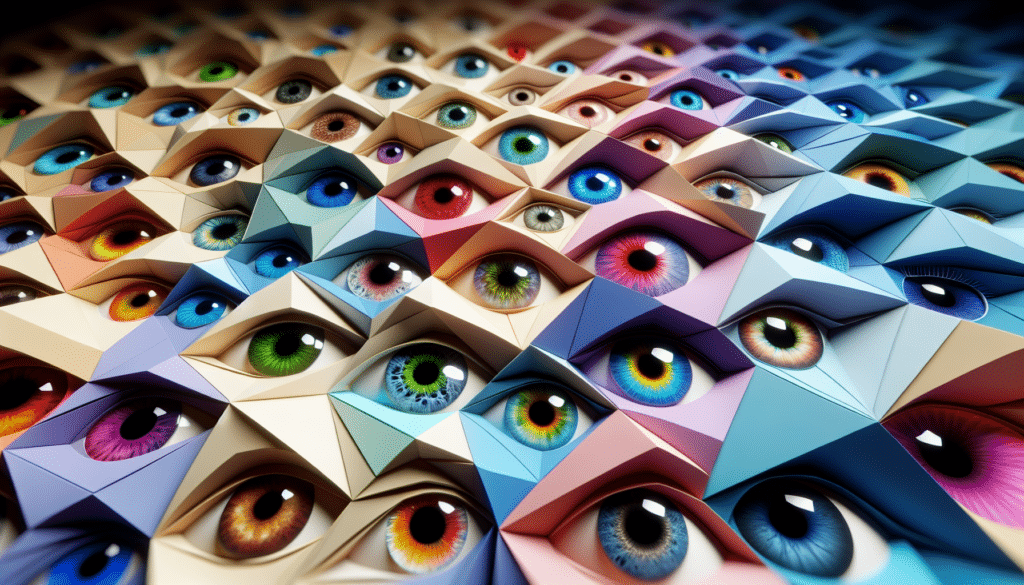What’s Up with Heterochromia?
Ever noticed someone with two different colored eyes? It’s called heterochromia, and it’s pretty cool. Celebs like Vanessa Williams rock it, making it even more fascinating. Let’s break down what it is and why it happens.
What is Heterochromia?
Heterochromia means having two different colored eyes or variations in color within the same eye. There are two main types:
Complete Heterochromia: Each eye is a different color. Think one blue eye, one brown eye.
Partial Heterochromia: Part of one eye is a different color from the rest or from the other eye. Imagine a mostly brown eye with a splash of blue.
This condition can be quite the head-turner. Vanessa Williams, with her unique eyes, is a perfect example.
Why Does It Happen?
The science behind heterochromia is pretty interesting. It all boils down to melanin, the pigment that gives eyes their color. Here’s how it works:
Genetic Mutations: Sometimes, genes that control melanin production get a little mixed up. These changes can be passed down from parents or happen out of the blue.
Environmental Factors: Injuries or illnesses can also mess with eye color. Conditions like Horner’s syndrome or Waardenburg syndrome can lead to heterochromia.
| Type of Heterochromia | Description |
|---|---|
| Complete Heterochromia | Each eye is a different color (e.g., one blue, one brown). |
| Partial Heterochromia | One eye has two different colors or a section of one eye is a different color. |
Knowing the genetic and environmental factors behind heterochromia makes it even more intriguing. Want to see more celebs with this condition? Check out Mila Kunis and Kate Bosworth.
Famous Faces with Heterochromia
Heterochromia is when someone has different colored eyes or even multiple colors in one eye. It’s a rare and cool trait that some famous folks rock, like Vanessa Williams.
Vanessa Williams’ Unique Eyes
Vanessa Williams isn’t just known for her talent; her eye color grabs attention too. She snagged the title of “Sexiest Green Eyes of the 21st Century” in a contest by The Green Eye Project (Planet Pooks). Initially, her blue eyes were a big deal when she won Miss America in 1984, sparking chats about beauty and race. Some folks even questioned if she was “Black enough” because of her light eyes (ELLE).
| Attribute | Detail |
|---|---|
| Eye Color | Blue/Green |
| Notable Achievement | First African American Miss America |
| Contest Win | “Sexiest Green Eyes of the 21st Century” |
Vivien Leigh’s Eye Controversy
Vivien Leigh, the unforgettable Scarlett O’Hara from Gone with the Wind, had eyes that kept people guessing. Often seen with green eyes in photos, her eye color sparked debates. Lighting, makeup, and photography played tricks, making her eye color a mystery.
Celebrities Embracing Heterochromia
Some celebs proudly show off their heterochromia, making it part of their unique charm:
- David Bowie: Bowie’s eyes were legendary. His left eye was blue, and his right was brown due to anisocoria.
- Mila Kunis: Kunis has one green eye and one brown, adding to her stunning look.
- Kate Bosworth: Bosworth’s eyes are a mix, with one blue and one hazel.
These stars prove that heterochromia isn’t just a genetic quirk; it’s a standout feature that makes them even more memorable.
Want to know more about these unique eyes? Check out the profiles of David Bowie, Mila Kunis, and Kate Bosworth.
The Magic of Eye Color
Beauty Standards and Eye Color
Eye color has always played a big role in how we see beauty. In the U.S., blue eyes are often seen as the gold standard, thanks to movies and ads. Remember Vanessa Williams? She broke barriers as the first African American Miss America in 1984, and her blue eyes made her stand out in a big way. Blue eyes are rare because they’re a recessive trait, which only adds to their charm.
Pop culture loves blue eyes too. Think of Brooke Shields—her blue eyes helped make her a star. This obsession with blue eyes can sometimes make other eye colors feel less special, shaping how we see beauty and ourselves.
Toni Morrison’s “The Bluest Eye” dives into this idea. The character Pecola dreams of having blue eyes to feel beautiful and accepted. This story shows how linking eye color to beauty can mess with our heads and our sense of worth (The Offing).
A Look Back at Eye Color
Eye color has always been more than just a physical trait; it’s been loaded with meaning. Lighter eye colors like blue or green have often been linked to wealth and beauty. This goes back to colonial times when lighter features were seen as better.
On the flip side, darker eye colors, common in people of African descent, haven’t always gotten the love they deserve. A black child with blue eyes can get all sorts of reactions, showing how deep our biases run.
Literature and art have also played into this. The push for lighter features versus the reality of darker skin tones creates a rich conversation about identity and beauty. Eye color becomes a way to look at how we see race and beauty, giving us a lot to think about.
Curious about other celebs with unique eyes? Check out the eye colors of David Bowie, Mila Kunis, and Kate Bosworth.
Myths and Realities of Eye Color
Blue Eyes in African Descent
Blue eyes in people of African descent often spark curiosity and debate. Blue eyes are a recessive trait, making them quite rare among black individuals. Historically, blue eyes in this group have been linked to a painful past, where it was assumed such traits resulted from rape during slavery or taboo interracial relationships (The Offing).
In the Solomon Islands, a unique mutation in the TYRP1 gene causes lighter skin and hair in about 26% of the population. This mutation is specific to the region and not found outside Oceania. This shows how genetics and history shape our views on eye color.
| Eye Color | Occurrence in African Descent | Historical Context |
|---|---|---|
| Blue | Rare | Linked to segregation and racial violence |
| Brown | Common | Dominant trait among African descent |
| Green | Very Rare | Often linked to mixed heritage |
Eye Color Inheritance
Eye color inheritance is a complex trait determined by multiple genes. This means two parents with dark eyes can have a child with lighter eyes, including blue or green. The idea that eye color is strictly determined by parental traits is a myth. Racial labels like “black” don’t reflect the diverse genetic backgrounds of individuals, which can include ancestry from various ethnicities (Quora).
The genetic inheritance of eye color shows how dominant and recessive traits interact. Brown is typically the dominant eye color, making it more likely to appear in offspring. However, recessive genes for lighter eye colors can still show up, especially in mixed-race families.
| Eye Color | Trait Type | Likelihood of Inheritance |
|---|---|---|
| Brown | Dominant | High |
| Blue | Recessive | Low |
| Green | Recessive | Very Low |
Understanding these myths and realities helps clear up the complexities surrounding eye color, especially in the context of celebrities like Vanessa Williams. Her unique eye color adds to her distinctive beauty, highlighting the diversity in eye colors across different ethnicities. For more on celebrities with unique eye colors, check out sections about Mila Kunis and David Bowie.
The Magic of Eye Colors
Eye color is like a box of crayons—full of surprises and influenced by a mix of skin tone and genetics. Let’s dive into what makes those peepers pop, including the stunning shades seen in stars like Vanessa Williams.
Skin Tone and Eye Color
The link between skin tone and eye color is pretty cool. While you might expect darker skin to pair with brown eyes, sometimes nature throws a curveball. Imagine someone with dark or naturally tanned skin rocking blue eyes—that’s a head-turner! This rare combo shows just how diverse eye colors can be across different ethnicities.
| Skin Tone | Common Eye Color | Rare Eye Color |
|---|---|---|
| Light | Blue, Green | Gray |
| Medium | Brown | Blue |
| Dark | Brown | Blue, Green |
Sometimes, eye color can skip a few generations and pop up in unexpected ways. Even in families with predominantly dark eyes, you might find a blue-eyed wonder, thanks to genes passed down from ancestors. It’s like a genetic lottery that keeps things interesting.
Genetic Wildcards
Genetics is the puppet master behind eye color. It’s a game of dominant and recessive traits, meaning two brown-eyed parents can have a blue or green-eyed kid, depending on their genetic mix. It’s like rolling the dice with DNA.
Take the Solomon Islands, for example. A unique mutation in the TYRP1 gene there leads to blond hair and unexpected eye colors. It’s a reminder that genetics can surprise us in the most colorful ways.
Understanding the variety in eye color not only makes us appreciate unique features like Vanessa Williams’ eyes but also shows how genetics and environment team up to create these beautiful traits. So next time you look into someone’s eyes, remember there’s a whole story behind those colors.
Eye Color Genetics
Ever wondered why some folks, like Vanessa Williams, have those mesmerizing eyes? Let’s break down the genetics behind eye color and see what makes those peepers pop.
Dominant and Recessive Traits
Eye color is a mix of dominant and recessive traits. Dominant traits usually lead to brown or hazel eyes, while recessive traits give us those lighter shades like blue or green.
| Eye Color | Trait Type |
|---|---|
| Brown | Dominant |
| Hazel | Dominant |
| Green | Recessive |
| Blue | Recessive |
So, if one parent has the gene for brown eyes (dominant), their kid is likely to have brown eyes too, even if the other parent has blue eyes (recessive).
Genetic Inheritance of Eye Color
Eye color inheritance isn’t as simple as we once thought. It’s not just a straightforward dominant-recessive deal. Recent studies show that multiple genes are involved, making eye color a polygenic trait. This means several genes work together to determine the final color, leading to a rainbow of possible shades.
Take, for example, someone of African descent with blue eyes. This can happen due to genes passed down from white ancestors, showing how genetics can surprise us with unexpected traits (Quora). It’s a reminder of the rich tapestry of our family histories.
Celebrities like Mila Kunis and David Bowie are perfect examples of how genetic inheritance can result in unique and captivating eye colors. Understanding these genetic patterns helps us appreciate the beautiful diversity in eye color.



